
Are ECM Upgrades Worth It?
November 9, 2021 | By Ian McTeer
HVAC service contractors encounter failed fan motors every day, it might be time to stock replacement units for customers interested in saving energy.
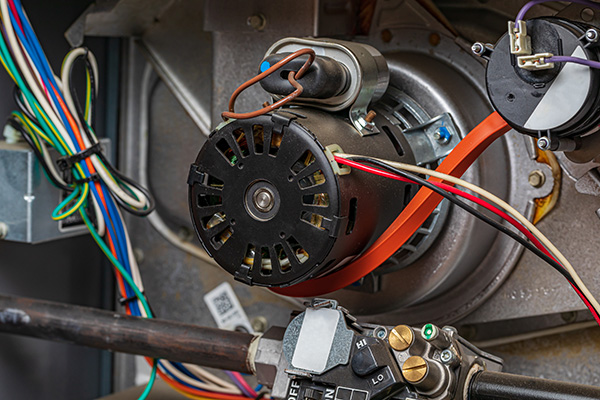
I know I’m sounding like a broken record, as I’ve made this statement many times in previous articles, but 1973 was a pivotal year for prescriptive Minimum Energy Performance Standards (MEPS) aimed at energy-using devices, not only in the HVAC industry but just about all other industries too.
The U.S., shocked by an oil embargo imposed by OPEC nations that year, started an immediate energy conservation campaign. One of the first rulings required all federal buildings to set cooling season conditions at 78F (25.5C) and 50% RH. National energy independence became the driver of efficiency initiatives until, of course, climate change came along.
It is not as if the HVAC industry went out of its way to be inefficient. I think it’s fair to examine the route taken and to wonder if such things as 97.5% AFUE gas furnaces would exist without a firm push from the government.
Uncomfortable AC
On the topic of HVAC efficiency, there is a hilarious YouTube video I saw of an old radio show featuring the 1950’s comedy duo Bob and Ray who act out a segment called “Wally Ballou at AC Factory” (have a listen). In the sketch, they have Wally interviewing a ficticious Mr. Martin Leppert, president of the Uncomfortable Air Conditioning Co.
At one point Mr. Leppert tells Wally his best customers are motel owners needing to be sure their customers leave at the proper check out time. One motel owner had a 10 am checkout time, but too many customers lollygagged past noon. So he installed Uncomfortable Air Units and now “hardly anyone sticks around past four in the morning, and the place is deserted by 6 o’clock.”
Now that’s funny, yet it points to a lingering issue whereupon even efficient units can be misapplied or operated inappropriately.
Even Mr. Leppert’s wacky AC unit needed electric motors to do the heavy lifting—providing “wind velocity of 38 knots.” The Bob and Ray parody had a lot to say about cooling systems, especially in public places like restaurants, auditoriums or theatres that kept patrons shivering rather than enjoying a well-conditioned space.
Central AC
Starting in the late 1970’s, residential gas and oil furnaces became the vehicle to move cooler conditioned air throughout a centrally heated house. Older forced warm air appliances were never meant to distribute cooler (denser) air through their unsuspecting duct systems.
Sometimes mixing signals without prior experimental data, cooling system installers were typically told to install a more robust fan motor along with an adjustable motor pulley usually set at 4-in. diameter. Increasing the speed of some early centrifugal blowers did little to improve airflow across bloated heat exchangers, notoriously small evaporator coils and through tight ductwork.
The furnace OEM often supplied a quarter horsepower, 115-volt, split phase AC motor. Often, the quarter horse motor would be replaced by a third horsepower motor and the aforementioned 4-in. motor pulley or drive sheave. Ideally, during the fall furnace maintenance, the drive sheave should have been opened a few turns slowing the fan thus increasing the furnace temperature rise.
As central cooling became more popular, furnace manufacturers developed furnaces and air handlers more attuned to add-on cooling systems; one of the most important improvements from that era had to be the direct drive fan assembly incorporating a Permanent Split Capacitor (PSC) motor. No more belts or pulleys combined with multiple motor speed taps meant fan speeds could be tailored for heating and cooling needs. Figures 1 and 2 below show a resilient mount PSC motor drive assembly.
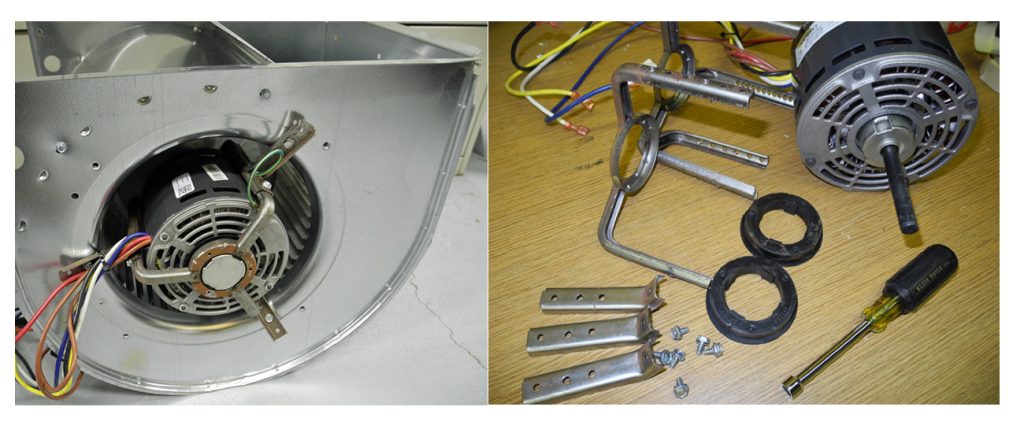
Resilient mount permanent split capacitor (PSC) motor drive assembly.
PSC Motor Slippage
PSC blower motors provided good service for decades. However, PSC motors can, at best, convert roughly 65% of their electrical input into mechanical work.
PSC motors suffer from asynchronous alignment, that is, the rotor constantly lags the magnetic field in the stator. Known as slippage, it means that a six pole PSC motor, for example, should turn at 1200 rpm.
The equation is: Synchronous Motor rpm = AC Frequency (Hz) x 120, then divide by the number of poles in the motor.
Thus, 60Hz x 120 = 7,200/6 should result in 1,200 rpm; however, slippage means the motor turns at 1,075 rpm.
Too much waste heat is the byproduct of slippage. PSC motors start abruptly adding stress to internal motor components and noise to the air handling system. Multi tap PSC motors must be carefully matched to the application as only minor changes in speed are possible.
Goodbye to the PSC Motor
In 2014, the U.S. Department of Energy (DOE) developed the Fan Efficiency Rating (FER) requiring furnace manufacturers to reduce fan electrical consumption by 40%. The FER standard came into effect on July 3, 2019.
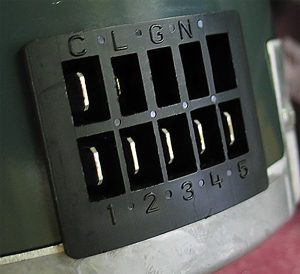
Example of a constant torque motor (CTM) 24 volt terminal.
Since then, residential gas furnaces and air handlers have been equipped with lower wattage electrically commutated motors (ECM) or constant torque motors (CTM). To help unload the overburdened electrical grid, DOE estimates efficient furnace fans alone will save approximately 3.99 quads of electricity thus saving consumers more than $9 billion on their electricity bills through to the year 2030.
HVAC industry OEM’s have adopted the CTM (also known as a brushless DC motor, or by its original moniker the X13 motor) in furnaces and air handlers since the inception of the FER rating standard in July 2019.
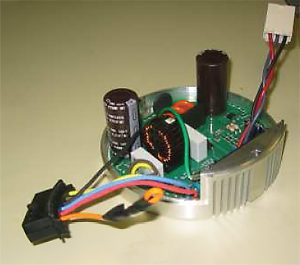
A look inside a typical CTM controller.
CTM’s are computer controlled and optimized around the principle of constant torque. Manufacturers test their furnace and air handler designs learning exactly how much torque the motor must provide to keep the centrifugal blower moving the necessary amount of air under all rated conditions.
The data collected is programmed into the motor computer. CTM’s provide several benefits over PSC motors and have similar characteristics to the more complex variable speed ECMs.
- CTM’s have the same ECM efficiency.
- Utilize a permanent magnet rotor.
- The CTM module creates a 3-phase power conversion from line voltage.
- Have a soft start capability.
- Use a simpler interface.
- Receive line voltage all the time.
Main differences:
- CTM’s do not ramp, less flexible, providing a fixed airflow as determined by low voltage applied to a specific terminal.
- Cannot be programmed to provide de-humidification mode or reduced speed for heat pump start-up in heating mode.
- CTM’s receive a 24-volt turn-on signal from the control board.
Electronically Commutated Motors – ECM
Developed by General Electric in the late ‘90’s, ECM’s have become the gold standard for improved efficiency and more flexible operation in residential HVAC air handling devices. ECM’s have a long list of features:
- Shared with CTM’s, these motors are wound like an industrial 3-phase motor with a computer that “decides” which winding to power at exactly the right time thus optimizing efficiency.
- The rotor consists of three permanent magnets; no energy is wasted in creating an armature magnetic field; low rotor losses mean almost no slippage.
- The motor computer, housed in a replaceable module, can control torque over a wide range of applications; provides a much wider range of airflows between lowest and highest settings.
- The motor computer “knows” the rotor position allowing control without the need for mechanical brushes and commutators.
- Motor starts softly and then ramps to proper speed.
- ECM’s used with furnace fans are optimized to provide constant air volume should the external static pressure change for some reason.
Come and Get Yer ECM’s!
Since X13s, CTMs and ECMs are brushless 3-phase DC motors with permanent magnet rotors, I’ll simply refer to all of them as ECM. Who would not want such an efficient motor driving a residential central air conditioning system?
Electric motor manufacturers such as Genteq Evergreen, Mars Azure Digi-Motor, and Nidec Rescue Select Pro have PSC to ECM field upgrades available for PSC-equipped furnaces and air handlers.
Indeed, HVAC service contractors encounter failed PSC fan motors every day, and with heating season coming on, it might be the time to stock several replacement units for customers interested in saving energy.
Motor manufacturers offer great features, research the product detail sheets for these particulars:
- Meant to replace direct drive furnace motors, not belted fan applications.
- Can replace PSC or X13 motors.
- Has an auto sizing mode, after 90 seconds of operation measuring ESP, it automatically assigns torque values to each speed tap.
- An optional PWM variable speed controller can be added to allow for 2 speed pots (one heating, one cooling) and allows motor speeds to be set at individual points between 350 rpm and 140 rpm.
- Motors are reversible.
- Standard outboard surge protector with dual voltage capability (115 or 230 vac).
- Pre-programmed with option to match OEM profile.
- Bluetooth or Near Field technology allowing for direct programming, customized airflows, and real-time diagnostics.
Is It Worth the Upsell?
The value proposition should go both ways; a great line item producing extra revenues for the contractor while fulfilling the promise of better performance, less noise, and reduced energy bills for the homeowner.
Thanks again to YouTube, motor manufacturers have created many useful training videos on how to replace PSC motors with an ECM. However, I would argue that a professionally-trained technician, well versed in the anomalies of substandard air handling systems, should be able to recognize that a dysfunctional duct system is not a worthwhile candidate for a motor efficiency upgrade.
So, what could go wrong? Moving a commodity like air through a duct system is work—a lot of work. One cubic foot of air weighs approximately 0.075 pounds. A blower moving 1,000 cubic feet of air per minute will move 0.075 x 1000 = 75 pounds of air per minute or 4,500 pounds (2.05 metric tons) of air per hour.
Suppose a dirty air filter restricts air entering the blower by 50%, or 37.5 pounds per minute. A PSC motor becomes unloaded, it goes on vacation doing less work: current draw decreases.

Example of a manufacturer’s chart showing readings at different rated external static pressures.
The chart above shows what happens to a variable speed ECM installed in a restrictive duct system. Notice the difference between motor watts at the manufacturer rated External Static Pressure (ESP) of 0.5-inch w.c. using the lowest possible heating speed on first stage, and the watts used in an overly restrictive system at 0.9-in. w.c.
In this case, airflow is reduced by a mere 2.7% (745 cfm – 725 cfm = 19cfm), but the motor watts increase by 55%.
A constant volume ECM will ramp up in a futile attempt to maintain programmed airflow. ECM powered fans, starved of air, will simply move whatever amount of air they can get at a higher velocity creating more noise.
ECM’s, often promoted as a method of easily overcoming airflow problems, typically operate well beyond rating plate maximum external static pressure in second-rate duct systems. Consistent operation at high wattage will likely be noticed by the homeowner who is expecting a lower electricity bill.
In the end, we are all fortunate that Mr. Leppert’s ficticious Uncomfortable Air Conditioning Company does not have a contractor’s division around here, yet, far too many HVAC systems could qualify as Uncomfortable.
Making the Switch
When it comes to replacing a PSC motor in an orphaned residential application, the technician needs to take basic system health measurements and then ask some important questions:
- When was the last time the furnace blower, secondary heat exchanger, and evaporator coil was cleaned?
- How often is the air filter maintained?
- Is the system noisy throughout the house?
- Are you unhappy with your comfort conditions?
- Would you be willing to sign a maintenance agreement with our company?
Too many negative responses to the above might mean a PSC motor is going to be the best replacement scenario.
Even better though, such systems should trigger a sales opportunity to replace the furnace and repair the air handling system so that a well-equipped furnace or air handler utilizing the latest ECM technology can provide the best value for the homeowner. <>
PSC to ECM Conversion Tips
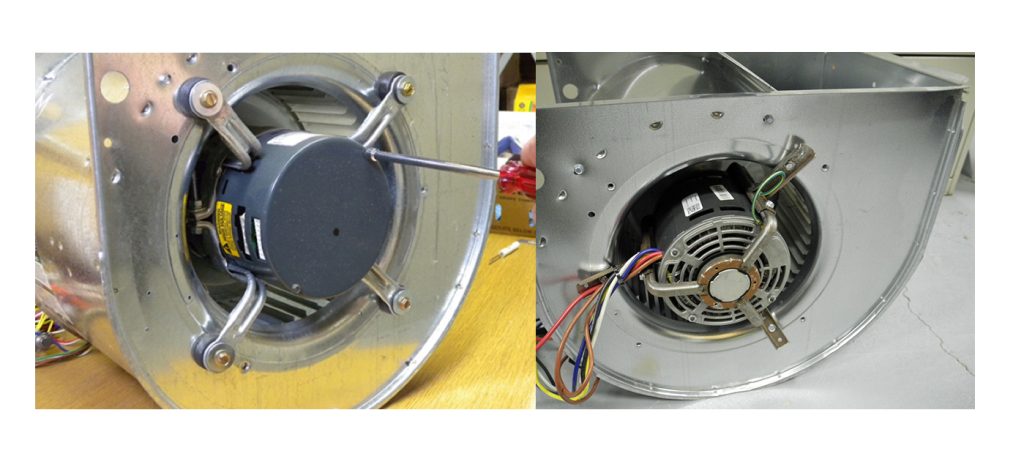
To convert a resilient mount PSC motor to an ECM, an aftermarket belly band motor mount will be required. Accessory belly band motor mount kits are available from various motor manufacturers. Best to use the mounting kit made by the same motor manufacturer.
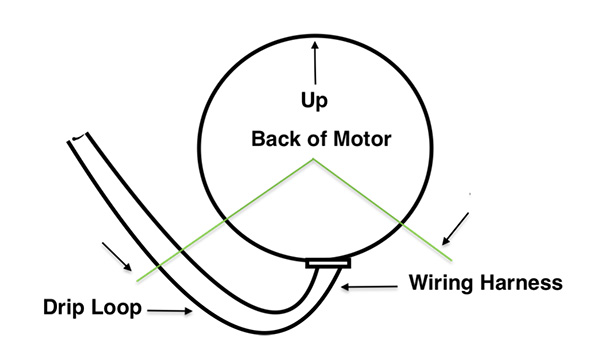
As installed in the air handler, the motor should be positioned with the connectors facing down between the 4 and 8 o’clock position, with the wiring harness formed into a drip loop.
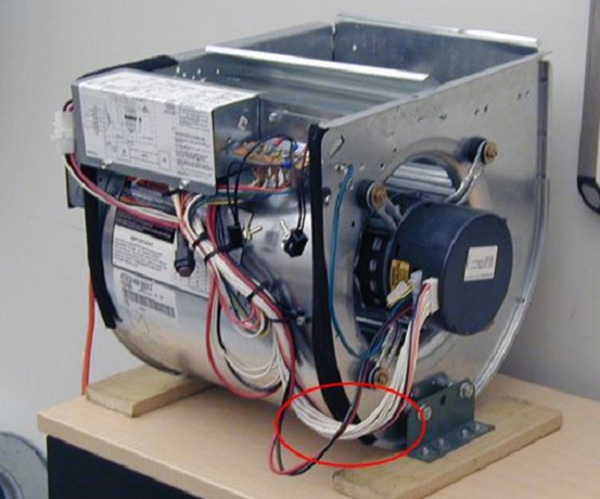
See the motor connection harness facing down with the drip loop on this OEM blower set-up. Drip loop prevents water dripping in the blower compartment from above making its way into the motor electronics.
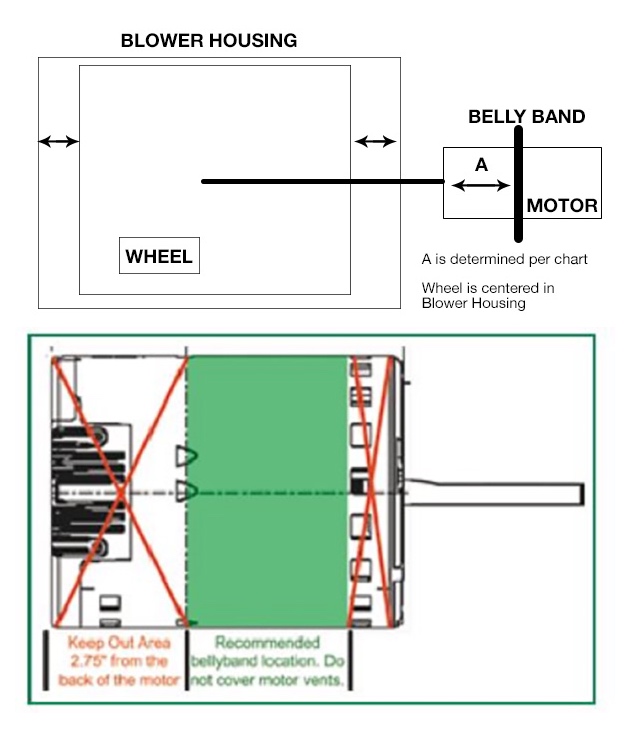
Motor insertion depth is important. Follow manufacturer’s instructions when installing replacement belly band mounts. Motors inserted too far into the fan, or not far enough, may cause the blower wheel to wobble causing noise, vibration and possible wheel failure.

 Ian McTeer is an HVAC consultant with 35 years experience in the industry. He was most recently a field rep for Trane Canada DSO. McTeer is a refrigeration mechanic and Class 1 Gas technician.
Ian McTeer is an HVAC consultant with 35 years experience in the industry. He was most recently a field rep for Trane Canada DSO. McTeer is a refrigeration mechanic and Class 1 Gas technician.


